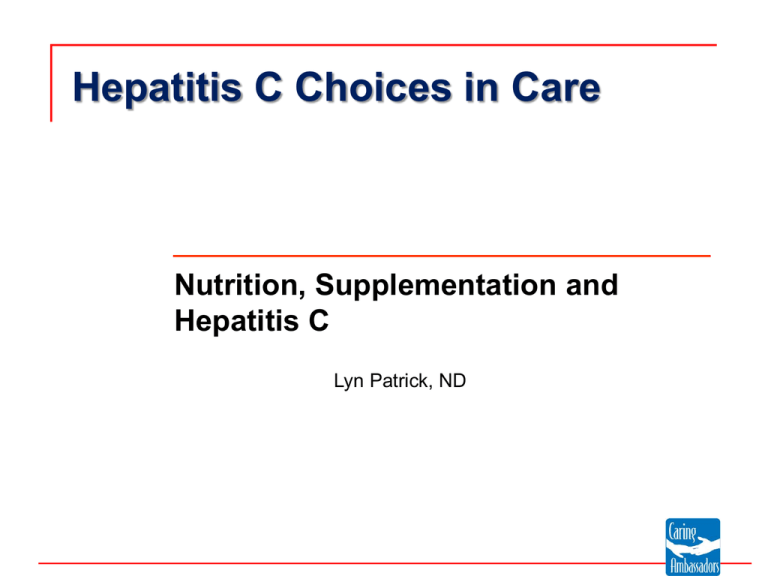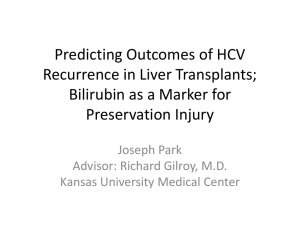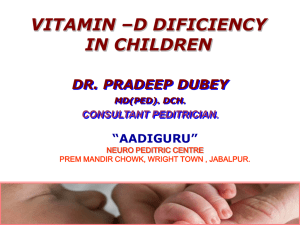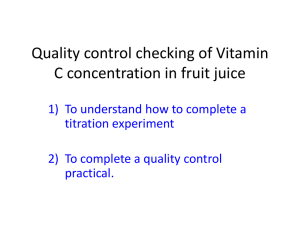
Hepatitis C Choices in Care
Nutrition, Supplementation and
Hepatitis C
Lyn Patrick, ND
What is Naturopathic Medicine?
The philosophy of naturopathic
medicine can best be described
as the utilization of the healing
power of nature.
What is Naturopathic Medicine?
All of the components of wellness are
equally important !!!
What is Naturopathic Medicine?
Naturopathic healthcare providers use many different
tools in the care and treatment of patients.
These include:
botanical medicines (herbs)
acupuncture
nutritional supplements
traditional Chinese medicine
homeopathic remedies
nutrition counseling and diet therapy
massage and/or spinal manipulation
exercise
and other forms of therapy
Naturopathic Medicine and
Who May Benefit
Naturopathic treatment options may benefit those who are
motivated to adopt the following healthy lifestyle
practices including:
a nutritious diet low in sugar, red meat, and processed foods
avoidance of smoking, alcohol, and recreational drugs
regular exercise
stress management
While these practices are helpful with any therapeutic approach,
they are vital to the success of naturopathic treatment.
Limiting Exposure to Liver-Damaging
Substances and Situations
Alcohol
Alcohol consumption is a significant risk factor for liver
cirrhosis.
Tobacco and Recreational Drugs
Both tobacco and marijuana use increase the risk of liver
cancer for people infected with HCV
Occupational Exposures
Exposure to pesticides, herbicides, and other chemicals can
cause liver damage and elevation of liver enzymes.
Limiting Exposure to Liver-Damaging
Substances and Situations
The potential for drug-herb interactions in people with liver
disease is complex and often unpredictable.
Keep all of your healthcare providers informed about
all medicines, herbs, and supplements you are
taking.
Never take any medicinal product if you are uncertain
about what it contains.
Why are Antioxidants Important in
Hepatitis C ?
Cellular damage occurs in an environment
that is high in free radicals and low in
antioxidants.
This causes cellular damage (inflammation and
fibrosis) that occurs as a result of the interaction
between the hepatic immune cells and the viral
infection.
Antioxidants and Fibrosis
Blood levels of the antioxidants glutathione,
vitamin A, vitamin C, vitamin E, and selenium
are much lower in HCV+ persons when
compared to people the same age and sex
who do not have hepatitis C.
Sanjiv KJ, et al. J Hepatol 2002;36:805-811.
Antioxidants in Hepatitis C
Glutathione is the main antioxidant in liver
and all mammalian tissue.
Glutathione is a sulfur-containing protein
that is used in detoxification, immune
function, and antioxidant protection in the
liver as well as all tissues in the body.
Glutathione levels are low in people with
hepatitis C.
Glutathione and Antioxidants
Vitamins E and C, alpha-lipoic acid,
selenium, and co-enzyme Q help recycle
glutathione so it can continue to work as an
active antioxidant, detoxification protein, and
immune stimulator.
Silymarin has been shown to raise liver
glutathione levels 35%, and is more potent
than vitamin E as an antioxidant.
Antioxidants and Fibrosis
Markers of oxidant stress in those with HCV
and low antioxidant levels were closely
connected to the amount of fibrosis in the
liver.
The higher the oxidant stress, the more
advanced the fibrosis. Fibrosis was also
connected to low levels of antioxidants in the
blood.
Sanjiv KJ, et al. J Hepatol 2002;36:805-811
Antioxidants and Fibrosis
Those in the study with significantly
elevated ALT levels (over 100) had the
most significant vitamin E deficiencies.
Genotype 1b had the lowest glutathione
levels of all genotypes.
Vitamin A
High doses of supplemental vitamin A can
be toxic to the liver.
Supplements may be necessary in cases of
vitamin A deficiency
It is safer to supplement with beta-carotene
or mixed carotenoids.
A safe dose of vit. A is 10,000-25,000 IU daily
Selenium and Liver Cancer
In a study of 7,342 men with HBV or HCV, those with
the highest selenium levels were 40% less likely to
get liver cancer than those with the lowest levels.
200 mcg of yeast-based selenium decreased the
incidence of liver cancer in HBV endemic area of
China by 33%.
Selenium deficiencies more significant in co-infection
(HIV/HCV).
Selenomethionine or yeast-based selenium is safest
and most absorbable.
A safe dose of selenomethionine is 200 mcg. daily
Yu MWAm J Epidemiol. 1999;150(4):367-374
Yu SYBiol Trace Elem Res. 1997;56(1):117-124.
Zinc
Zinc has been shown to be one of
the nutrients that may be deficient in
those with hepatitis C.
Zinc may be useful in the prevention
and treatment of hepatic
encephalopathy.
Zinc
Zinc is less absorbable in those with
cirrhosis.
Zinc is twice as absorbable in those with cirrhosis when
taken between meals.
Zinc citrate, picolinate, septahydrate are
more absorbable than zinc oxide,
gluconate, or sulfate.
A safe dose of zinc is 30-60 mg. daily
Those with cirrhosis may need higher
doses
Vitamin E
Fat soluble vitamin found in oils, cereal grains,
animal fats, fruits, and vegetables.
Naturally occurring vitamin E consists of a complex
of 8 different forms found in foods:
alpha-tocopherol
beta-tocopherol
gamma-tocopherol
delta-tocopherol
4 types of tocotrienols
Vitamin E
Most of the vitamin E found in food is gammatocopherol.
Most of the commercially available vitamin E and
the form used in many studies is synthetic Lalpha tocopherol isomer (not the d-form).
The forms used in the recent meta-analysis were
not disclosed but can be assumed to be alphatocopherol only and probably the L-isomer.
Vitamin E
Synthetic vitamin E (l-alpha tocopherol with
no other tocopherols or tocotrienols) has
ability to bind to receptor sites, potentially in
favor of biologically active forms of vitamin
E (d-alpha-, beta-, delta-, and gammatocopherol) and may even be harmful.
Vitamin E
May improve response to interferon.
1200 IU for 8 weeks in HCV+ completely
blocked the biochemical pathway leading to
fibrosis.
Vitamin E at 1200 IU is contraindicated in
coumadin therapy and with vitamin K
deficiency.
•Look
MP, et al. Antiviral Res. 1999;43(2):113-122.
K Gastroenterology. 1977;113(4):1069-1073
•Houglum
Alpha-Lipoic Acid (ALA)
ALA has been used to treat diabetic
peripheral neuropathy and acute liver failure
in Europe.
Because it is active in both fatty tissue and
non-fatty tissue, it has a wide range of activity
as an antioxidant.
www.voy.com/17059/190.html for an interview with Lester Packer PhD, ALA researcher
ALA raises Glutathione Levels in
Humans with Low Glutathione
ALA is effective at a lower molecular
concentration and a lower dose than NAC:
450 mg raised glutathioine levels in HIV+ in 14
days
Doses of 600 mg equivalent in animal and in
vitro studies have raised glutathione levels
significantly.
Fuchs J, et al. Arzneimittelforschung 1993;43:1359.
S-Adenosyl Methionine (SAMe)
Used in Europe to normalize bile secretion
in chronic liver disease.
Studies in HBV and HCV showed reduction
of itching, jaundice, fatigue, and lowering of
bilirubin in median of 16 days.
Dosages used: 800-1600 mg daily
Difficulties: cost and storage (easily
oxidized)
Enhancing Response to Treatment
SAMe and betaine- improve interferon’s effect
in presence of HCV
a cohort of 29 HCV +( 80% genotype 1, 72%
cirrhotic) who had previous non-response to
standard therapy were given
SAMe 400 mg tid
Betaine 3 g bd (anhydrous)
One week lead-in and then 24 wks standard therapy
with pegINF and ribavirin
PLoS ONE 5(11):3 15492. doi: 10.1371/journal.pone.0015492
Preventing Side Effects
During Treatment-HCV
EPA- 1.2 grams daily
Vit. C- 600 mg. daily
Vit. E- 300 IU daily
Prevented low white cell counts, T-helper 1
decline and improved 48 week red blood cell
iron levels
Lipids 2008;43:325.
Preventing Side Effects
During Treatment: HCV
500 IU E, 750 mg C
able to prevent drop in EPA levels in
RBCs indicating a decreased risk for
hemolytic anemia from ribavirin
Nutrition 2006;22:114.
What I Use
Vit. E- 1000 IU mixed tocopherols
Vit. C- 3000 mg bd or 2000 mg td
EPA- 1.2 gm from krill oil
why krill?- astaxanthin BUT expensive so
use a good mercury-free PCB-free fish oil
if money is an issue
Preventing Side Effects
During Treatment
Zinc (zinc/L-carnosine chelate)- 150 mg.
decreased gastrointestinal side effects during
48 week course of peg-interferon/ribavirin
treatment.
Zinc (zinc/L-carnosine chelate)-in addition to
300 IU vit. E and 600 mg vit. C improved
both EVR at 12 wk and at 48 wk and
prevented anemia due to treatment
World J Gastroenterol 2006;12:1265.
Vitamin D Levels
Deficiency is common: 93% of patients in
liver disease clinics have been found to be
vitamin D deficient, African-American females
and those with cirrhosis have highest risk
Low vitamin D levels are related to:
Poor response to standard treatment
Increased risk of fibrosis
Dig Dis Sci 2010;55:2624
Gastroenterol Heptol 2010;6:491.
Hepatology 2010;51:1158.
Vitamin D: Impact on virologic response
Randomized Study, 58 patients G1, treatment naïve
PEG-IFN-2b (1.5 mcg/kg) + RBV (1000-1200 mg) + Vit D (1000-4000 IU)
(27 patients, median age 47, 50 % male, 55 % > F2)
PEG-IFN-2b (1.5 mcg/kg) + RBV (1000-1200 mg) + placebo
(31 patients, median age 49, 60 % male, 18 % > F2)
100
HCV RNA undetectable(< 50 IU)
96 %
80
Placebo + PEG-IFN/RBV
60
44 %
%
48 %
Vitamin D + PEG-IFN/RBV
40
18 %
20
0
S4
AASLD 2009 – Abu-Mouch S, Israël, Abstract LB20 actualisé
S12
Improving Outcome on Treatment:
Phosphatidylcholine in HCV
In monotherapy trial of interferon alpha 2a or 2b x 24
wks:
treatment with 1.8 g of PPC during and 24 wks post tx:
significant improvement in biochemical response vs interferon
alone (71% vs. 56%)
significant improvement in sustained response 24 wks post tx
vs interferon alone (41% vs 15%)
NO effect on biochemical response or viral clearance in HBV
Conclusion: PPC may be recommended in interferon
monotherapy during and after tx to reduce relapse rates
Hepatogastroenterology 1998;45:797
Silymarin and HCV
evidence that it does not improve ALT levels
even on 1260 mg day
BUT silymarin use in 367 patients in a large
group(HALT-C trial):
less fibrosis at beginning
less histological progression than non-users in
the following 8.65 years (HR .57)
Eur J Res 2005;10:68
J Gastroenterol Hepatol 2006;21(1 pt2):275.
Aliment Pharmacol Ther 2011;333:127
Silymarin and HCV
Probiotics
Probiotics have been shown to reverse fatty
liver disease in animal models and decrease
portal hypertension in isolated cases of
cirrhosis
Probiotics (plus fiber called
fructooligosaccharides = synbiotics) work as
well as lactulose in those with cirrhosis who
have hepatic encephalopathy
Acetyl-L-carnitine
An amino acid found in food (meat)
Acetyl-L-carnitine has also been
shown to be effective in treating
minimal hepatic encephalopathy
dosage: 2 g bd
Dig Dis Sci 2008;53:3018.
Zinc in HCV and Progression to
Cirrhosis
Zinc in HCV and Progression to
Cirrhosis
Zinc carnosine (Polaprezinc) = 34 mg.
elemental zinc qd
Significantly lower incidence of hepatocellular
carcinoma
Slower fibrosis progression
In those on zinc who had increase in blood
levels
Conclusions: weight-based dosing (.6 mg/kg)
S-adenosylmethionine (SAMe)
Physiologic compound involved in
transmethylation and transsulfuration
occuring primarily in the liver.
Parenterally and orally (1600 mg. daily)
effective for treating cholestasis of chronic
liver disease
SAMe oxidizes- that’s why it’s sold only in
blister paks in Europe, should be the same
way in U.S.
Frezza M. Gastroenterol 1990;99:211.
S-adenosyl methionine (SAMe)
SAMe has been shown to delay the need for liver
transplantation and reduce mortality in patients with
alcoholic cirrhosis in a 24-month trial
Overall mortality/liver transplantation was 12% on SAMe
versus 29% in placebo group.
Those with hepatitis C had a survival risk ratio of 4.5
compared to placebo.
Oral administration of 1200 mg. SAMe daily has been
shown to significantly increase hepatic glutathione levels
in nonalcoholic liver disease.
J Hepatol. 1999;30(6):1081-1089.
Scand J Gastroenterol 1989;24(4):407.
SAMe
Studies in patients with chronic hepatitis B and
chronic hepatitis C have shown reduction of
itching, jaundice, fatigue, and lowering of
bilirubin in median 16 days.
Dosages used: 800-1600 mg. daily
Difficulty- cost, oxidizes easily
vit. K2- menaquinone
40 women with HCV and cirrhosis: 21 on vit.
K2 45 mg. qd compared to 19 on no
treatment
8 years later-risk of getting HCC with vit. K2
was reduced by 80% 1
Vit. K has also been found to suppress HCC
recurrence in patients with prior diagnosis of
HCC.2
1.JAMA 2004;292:358
2.Vitam Horm 2008;78:435.
Carotenoids/Myo-inositol
Randomized, controlled study HCC prevention
in chronic hepatitis with cirrhosis: ( 24 treated
vs 45 matched controls)
1 gram myo-inositol and 3 grams βcryptoxanthin as 190 ml mandarin orange juice
10 mg. lycopene, 6 mg β-carotene, 3 mg αcarotene, 50 mg α-tocopherol, 1 mg. other
carotenoids
for 2.5 years
Nutr Cancer 2009;61:789.
Supplement Precautions
High doses of supplemental vitamin A can be
toxic to the liver in HCV infection but may be
necessary in cases of vitamin A deficiency
(advanced cirrhosis)
Patients with chronic liver disease should
consume less than 25,000 IU of vitamin A per
day.
Iron should be avoided in any supplemental form
altogether unless anemia is present.
Riley T. Am Fam Phys 2001;64:1555.
Role of Diet in Chronic
Hepatitis C Management
protein: increased need in chronic liver
disease
fat: saturated vs. unsaturated, high in omega3, minimal trans fatty acids
insulin resistance common: multiple small
meals with complex COH
J Nutr Met 2010; doi:10.1155/2010/489823
Protein
1.2-1.5 gm/kg/day in chronic liver disease
without cirrhosis
(average 150 lb. adult = 70-100 gms/day)
1.0 gm/kg/day with severe hepatic
encephalopathy but only for short period of time
short-term low protein diet (20-60 grams/day) if
acute encephalopathy occurs, only for 2-3 days
to control ammonia
animal vs vegetable- 71 grams/day vegetable
improved metal status of cirrhotics with hepatic
encephalopathy
J Intern Med 1993;233(5):385
Fats/Digestive Support
Cholestasis is common in chronic hepatitis C
and results in loss of ability to concentrate
bile salts: fat malabsorption, fat-soluble
vitamin deficiencies and steatorrhea
Lipase-containing digestive enzymes
(pancreatin) can aid malabsorption: Lipase
2000-4000 NF in 500-1000 mg. pancreatin
Drugs that may lead to
Cholestasis
Natural and synthetic steroid hormones
(OCP, anabolic steroids, HRT)
Antibiotics
Diuretics
NSAIDs
Thyroid hormone (T4)
Western Botanicals Used In
Hepatitis C
Curcumin- unhibits fatty liver and fibrosis in
animal models
Green Tea (EGCG)- decreased fatty liver
when fed at human weight equivalent of 7
ounces (whole plant powder)
Shown to inhibit fibrosis in animal or cell
models: resveratrol, quercitin, silymarin,
Scutellaria (Skullcap)
Appreciation and Acknowledgement
Lorren Sandt Program Director
Hepatitis C Caring Ambassador Program
Oregon City, OR
Robert Gish MD University of California, San
Diego School of Medicine Co-Director Center
for Hepatobiliary Disease and Abdominal
Transplantation San Diego, CA
Stewart Cooper MD Director Liver Immunology
Laboratory at California Pacific Medical Center
San Francisco, CA
Misha Cohen OMD. LAc Assistant Researcher
for Integrative Medicine at the UCSF Institute for
Health and Aging San Francisco, CA








